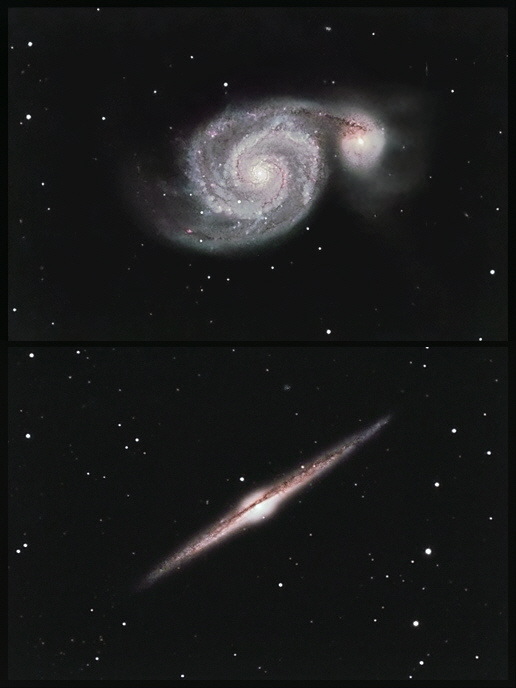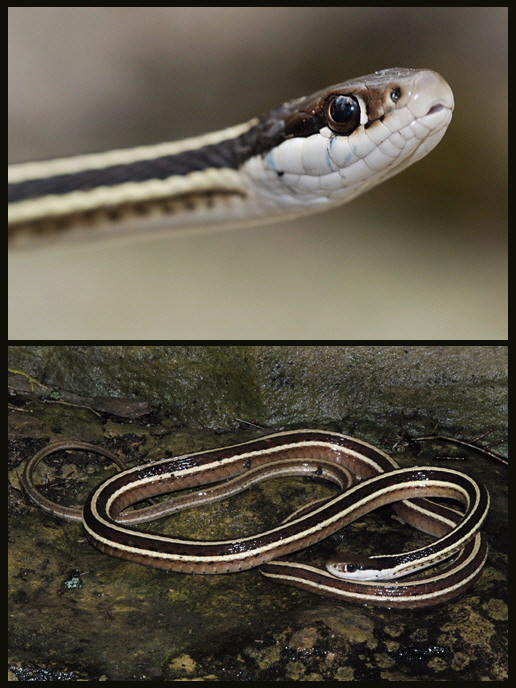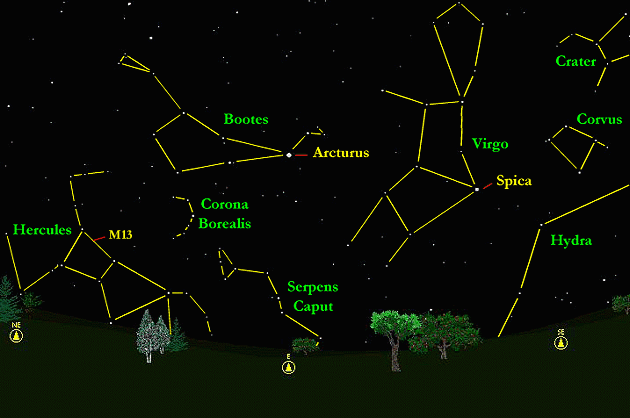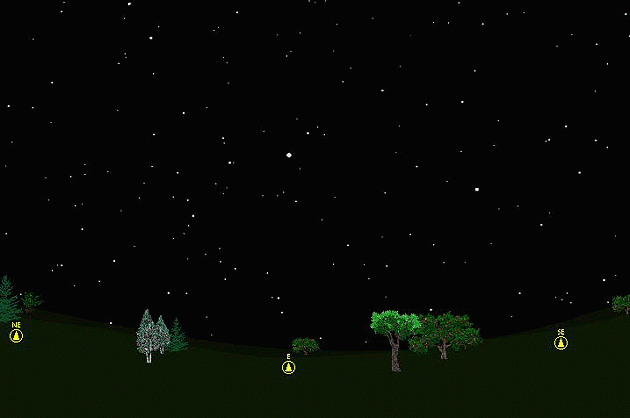The purpose of this feature is to give scout leaders, educators and naturalists an idea of some of the natural events coming up each month. We will try to cover a variety of natural events ranging from sky events to calling periods of amphibians, bird and mammal watching tips, prominent wildflowers and anything else that comes to mind. We will also note prominent constellations appearing over the eastern horizon at mid-evening each month for our area for those who would like to learn the constellations. If you have suggestions for other types of natural information you would like to see added to this calendar, let us know! Note: You can click on the hyperlinks to learn more about some of the featured items. To return to the Calendar, hit the "back" button on your browser, NOT the "back" button on the web page. All charts are available in a "printer friendly" mode, with black stars on a white background. Left clicking on each chart will take you to a printable black and white image.
Notes and Images From March 2008
Amateur astronomers have a peculiar mindset. When we see an image of a galaxy, we often think of an evening under the stars, a campsite long ago with a clear sky, or the smell of a Ponderosa Pine forest at twilight. Spring is the time when many of the great galaxies rise in the early evening and slowly parade overhead. In March I imaged two of my favorite spring galaxies. Messier 51, the Whirlpool Galaxy, is in Canes Venatici, near the tail of the "big dipper." NGC 4565 is nearby in Coma Berenices. Both are about the same altitude at dusk in the northeast. M51 has a companion galaxy, NGC 5195, that has in the past interacted with it and caused its spiral arms to be somewhat sprung. While M-51 and NGC 4565 are both about 30 million light-years from us, we see the face of M51 and its companion, while we see NGC 4565 edge-on. The great clouds of stars and dust ringing NGC 4565 are well seen in the image above. We have a similar equatorial dust lane around our own galaxy, and we see this plane of stars and dust when we look at the Milky Way. To see an artist's representation of the position of our sun in the Milky Way Galaxy, click here. You might want to look at the spectacular Milky Way images by Axel Mellinger and see if you can relate the Milky Way's appearance in the sky to the sun's position within the Milky Way Galaxy. Also seen in the background of both images are many, many small faint galaxies. Click on the image to see some of the background galaxies identified with red tick marks. On both images all of the foreground stars belong to our own galaxy, so try to imagine these stars quite close to you. A rough analogy would be looking out your bedroom window on a snowy night at a streetlight a mile away (the galaxy). The foreground stars would be like the flakes of snow on your window pane, 6 inches away from your nose.
On March 29th, we helped with a "bioblitz" in Cheatham County organized by the Austin Peay State University Wildlife Society. Despite some rain showers, it was a very enjoyable day, and we were fortunate to find this Eastern Ribbon Snake beneath a small log. Ribbon Snakes can be distinguished from similar-looking Garter Snakes by the lack of black edging along the lip scales and a less checkered appearance on the back. They are more aquatic than Garter Snakes, and are often found near ponds, marshes, swamps, streams and rivers. Their primary food is amphibians, but also includes many kinds of invertebrates, fish, small snakes, mice and shrews. They are uncommon in Middle and East Tennessee, becoming more common in the western part of the state.
Sky Events for April 2008: The Lyrid Meteor Shower peaks on the night of April 21st and the morning of April 22nd. This is a not a very strong annual shower and unfortunately a waning gibbous moon will tend to wash out the sky. Evening Sky: Saturn is bright and beautiful in the evening sky. This is a great time to see the ringed planet. Just about any small telescope will deliver a striking view. At dusk around mid-month, look for it about 65 degrees above the horizon in the southeast, near the bright star Regulus in Leo. Mars is now only about 7 arcseconds in apparent diameter, and a very small telescopic target. Look for it in central Gemini, about 60 degrees above the WSW horizon at dusk at mid-month. Be sure to look for the three-day-old crescent moon near the Pleiades on the evening of April 8th. Start looking about 30 minutes after sunset. Binoculars should give a beautiful view of the pairing. Morning Sky: Jupiter rises about 1:50am in Sagittarius at mid-month. All times noted in the Sky Events are for Franklin, Tennessee and are Central Daylight Time. These times should be pretty close anywhere in the mid-state area.
Constellations: The views below show the sky looking east at 9:00pm CDT on April 21st. The first view shows the sky with the constellation outlined and names depicted. Star and planet names are in yellow. Constellation names are in green. The second view shows the same scene without labels. New constellations this month in the eastern sky are Serpens Caput, the Serpent (Head), and Hercules, the Strongman. As spring progresses and Hercules rises higher in the sky, look for the globular cluster Messier 13 (M13), which appears like a small fuzzy patch of light about 1/3 of the distance between Eta and Zeta Hercules (see illustration below). A cluster of stars about 21,000 light years away, M13 can be made out with the naked eye in a dark country sky when the constellation is high in the sky. Binoculars help pick it out.
On Learning the Constellations: We advise learning a few constellations each month, and then following them through the seasons. Once you associate a particular constellation coming over the eastern horizon at a certain time of year, you may start thinking about it like an old friend, looking forward to its arrival each season. The stars in the evening scene above, for instance, will always be in the same place relative to the horizon at the same time and date each April. Of course, the planets do move slowly through the constellations, but with practice you will learn to identify them from their appearance. In particular, learn the brightest stars (Like Arcturus and Spica in the above scene looking east), for they will guide you to the fainter stars. Once you can locate the more prominent constellations, you can "branch out" to other constellations around them. It may take you a little while to get a sense of scale, to translate what you see on the computer screen or what you see on the page of a book to what you see in the sky. Look for patterns, like the stars that make up the constellation Corvus. The earth's rotation causes the constellations to appear to move across the sky just as the sun and the moon appear to do. If you go outside earlier than the time shown on the charts, the constellations will be lower to the eastern horizon. If you observe later, they will have climbed higher. As each season progresses, the earth's motion around the sun causes the constellations to appear a little farther towards the west each night for any given time of night. If you want to see where the constellations in the above figures will be on May 20th at 9:00pm CDT, you can stay up till 11:00pm CDT on the April 20th and get a preview. The westward motion of the constellations is equivalent to two hours per month. Sky Publishing has just come out with a beautiful and compact star atlas, Sky & Telescope's Pocket Star Atlas. It is destined to become a classic, and is a joy to use at the telescope. A good book to learn the constellations is H. A. Rey's
classic,
The Stars, A New Way to See Them. Rey's depictions of the
constellations and witty commentary are terrific. A good general reference book on astronomy is the Peterson
Field Guide,
A Field Guide to the Stars and Planets, by Pasachoff.
The book retails for around $14.00. Starry Night has several software programs for learning the night sky. Visit the Starry Night web site at www.starrynight.com for details.
Amphibians:
This has been a relatively warm spring, and we've already heard Southeastern Chorus Frogs, Spring Peepers, Southern Leopard Frogs, American Toads, Northern Cricket Frogs, and Cope's Gray Treefrogs. The early calls of Gray Treefrogs sound raspier than the normal trill, as if the frog needs to clear its throat. They sometimes call from small tree cavities on warm days.
Birds: The spring migration builds very quickly in April. The neo-tropical migrants are too numerous to list here, but now is the time to get out in the early morning with a pair of binoculars and welcome the new arrivals for the day. Listen at dusk for young Great Horned Owls and Young Barred Owls, doing their raspy "begging" calls. Recommended: Bird Finding in Tennessee, Michael Lee Bierly. A classic guide to finding birds in Tennessee. The Sibley Guide to Birds, David Allen Sibley The Sibley Guide to Birds of Eastern North America, David Allen Sibley An inexpensive guide for beginners is the Golden Guide for Birds.
Wildflowers: Some of our favorite Spring wildflower walks are: The south ridge at the Owl's Hill Nature Center in Brentwood, Tennessee. The Edwin Warner paved loop at the Warner Parks in Nashville or just about any trail in Warner Parks. The Angel Falls trail along the Cumberland River at the Big South Fork Recreational Area, near Jamestown, Tennessee.
Archives (Remember to use the back button on your browser, NOT the back button on the web page!) Natural Calendar February 2008 Natural Calendar December 2007 Natural Calendar November 2007 Natural Calendar September 2007 Natural Calendar February 2007 Natural Calendar December 2006 Natural Calendar November 2006 Natural Calendar September 2006 Natural Calendar February 2006
Natural Calendar
December 2005
Natural Calendar
November 2005
Natural Calendar
September 2005
Natural Calendar
February 2005
Natural Calendar
December 2004
Natural Calendar
November 2004
Natural Calendar
September 2004
Natural Calendar
February 2004
Natural Calendar
December 2003
Natural Calendar
November 2003
Natural Calendar
September 2003 Natural Calendar February 2003 Natural Calendar December 2002 Natural Calendar November 2002 Nature Notes Archives: Nature Notes was a page we published in 2001 and 2002 containing our observations about everything from the northern lights display of November 2001 to frog and salamander egg masses. Night scenes prepared with Starry Night Pro software All images and recordings © 2008 Leaps
|




